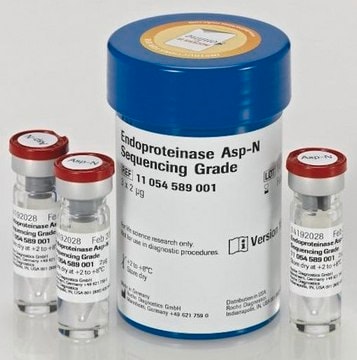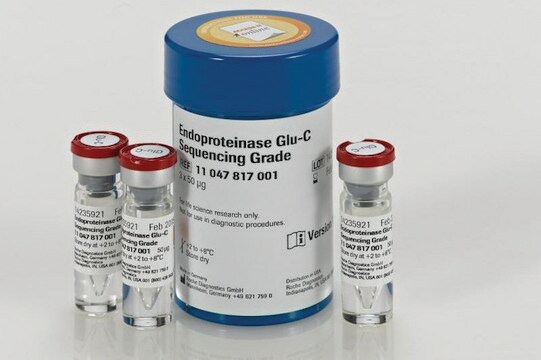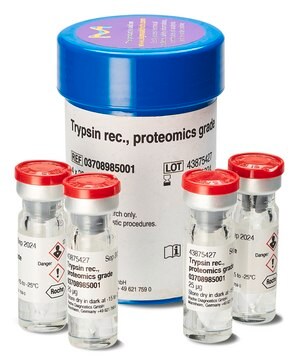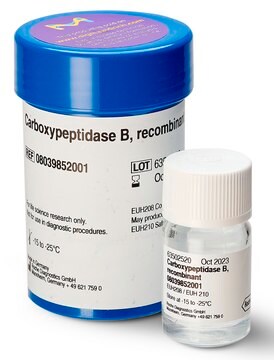Key Documents
ENDOLYSS-RO
Roche
Endoproteinase Lys-C Sequencing Grade
from Lysobacter enzymogenes
Synonim(y):
lys-c, lysyl endopeptidase, protease
About This Item
Polecane produkty
pochodzenie biologiczne
bacterial (Lysobacter enzymogenes)
klasa czystości
protein sequencing grade
Postać
lyophilized
aktywność właściwa
≥200 units/mg protein (at 25 °C, with Chromozym PL)
masa cząsteczkowa
33 kDa by SDS-PAGE (reducing)
oczyszczone przez
electrophoresis
opakowanie
pkg of 3 × 5 μg (11047825001)
pkg of 5 μg (11420429001)
producent / nazwa handlowa
Roche
warunki przechowywania
(Keep container tightly closed in a dry and well-ventilated place.)
metody
activity assay: suitable
kolor
white
optymalne pH
8.5-8.8
zakres pH
5-12
rozpuszczalność
water: soluble
przydatność
suitable for enzyme test
numer dostępu UniProt
temp. przechowywania
2-8°C
Powiązane kategorie
Opis ogólny
Specyficzność
Heat inactivation: Enzyme can be denatured using heat (5 min at 100 °C) or by TCA.
Zastosowanie
Uwaga dotycząca przygotowania
Rekonstytucja
Stable in 4 M urea.
Inne uwagi
Kod klasy składowania
11 - Combustible Solids
Klasa zagrożenia wodnego (WGK)
WGK 2
Temperatura zapłonu (°F)
does not flash
Temperatura zapłonu (°C)
does not flash
Certyfikaty analizy (CoA)
Poszukaj Certyfikaty analizy (CoA), wpisując numer partii/serii produktów. Numery serii i partii można znaleźć na etykiecie produktu po słowach „seria” lub „partia”.
Masz już ten produkt?
Dokumenty związane z niedawno zakupionymi produktami zostały zamieszczone w Bibliotece dokumentów.
Nasz zespół naukowców ma doświadczenie we wszystkich obszarach badań, w tym w naukach przyrodniczych, materiałoznawstwie, syntezie chemicznej, chromatografii, analityce i wielu innych dziedzinach.
Skontaktuj się z zespołem ds. pomocy technicznej





